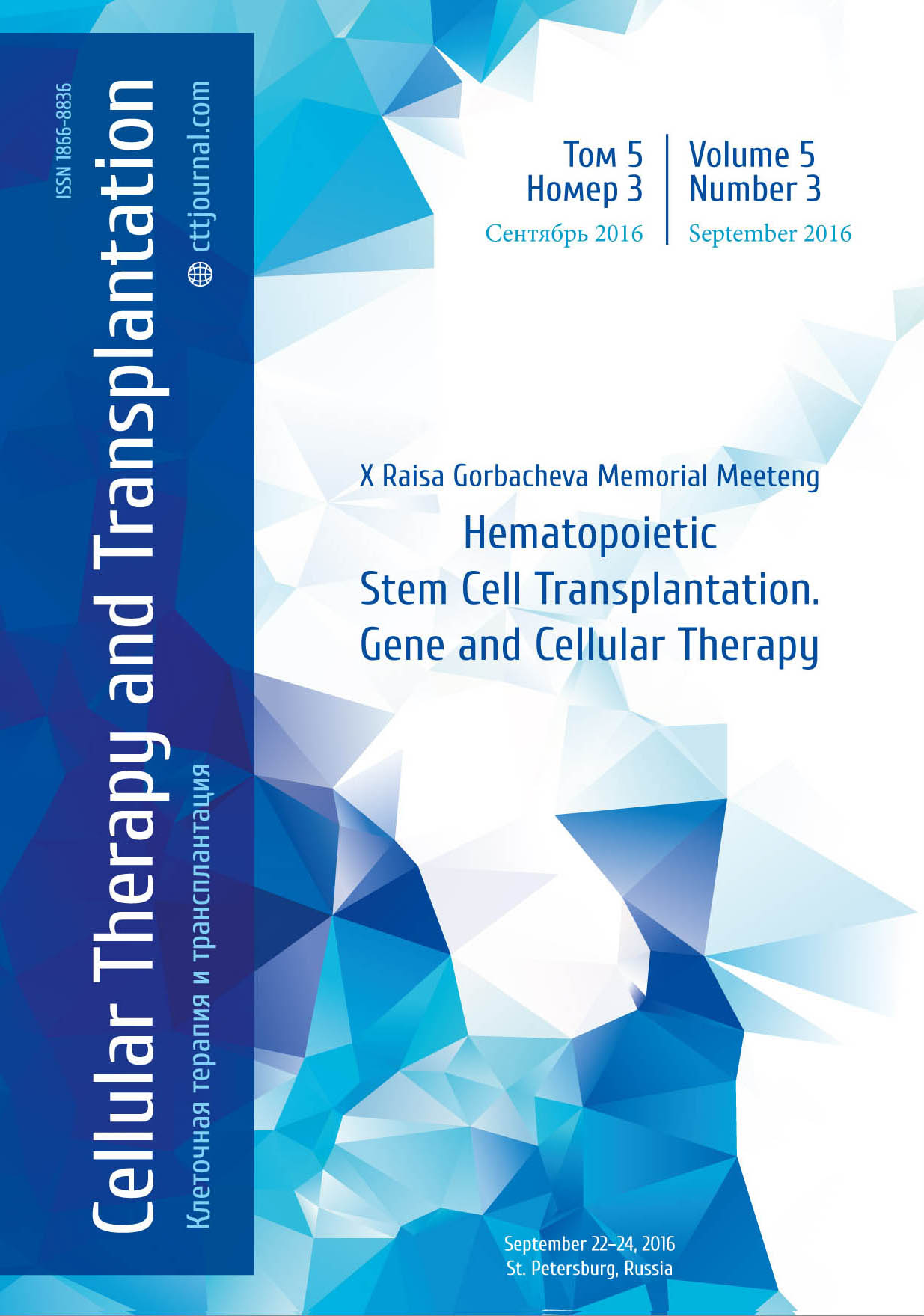Alterations in multipotent mesenchymal stromal cells properties: in vitro model of their interactions with allogeneic lymphocytes
Contact: Dr.Nikolay M. Kapranov
E-mail: kapranov.n@blood.ru
Accepted 20 September 2016
Summary
Background
Multipotent mesenchymal stromal cells (MSCs) possess immunomodulatory properties and were successfully used for treatment of autoimmune diseases and acute or chronic graft-versus-host disease (GVHD) after allogeneic hematopoietic cells transplantation. Therapy with MSCs is not always effective. It has been shown that immunomodulatory properties of the MSCs may be improved by means of various agents, such as IFN-γ, TNF-α, IL-17. Characteristics of MSCs after injection into the patients differ from those which have been studied in culture, due to their interactions with other cells in bloodstream and tissues. In this study, an attempt was made to develop a model of IFN-γ-treated MSCs (IFN-γ-MSC) and their in vitro interactions with allogeneic lymphocytes. The aim of the study was to identify the changes of MSCs and IFN-γ-MSC characteristics after co-cultivation with lymphocytes in vitro and to determine the level of expression of CD90 (Thy-1) – MSCs marker characterizing the degree of differentiation, in dynamics.
Materials and methods
MSCs were isolated from donor bone marrow (n=13) harvested at the Department of Bone Marrow Transplantation (NRCH) from healthy donors under their informed consent, and cultured by a standard method in aMEM with 10% fetal bovine serum (FBS). After 2-3 passages, the MSCs were seeded at 105 cells per flask with 25 cm2 bottom area, and 500 units/mL of IFN-γ were added a day later for 4 hours to half of the cultures. Then the media were changed either without lymphocytes or with 106 allogeneic lymphocytes in RPMI-1640 medium with 10% FBS. 5 mg/ml phytohemagglutinin (PHA) was added to the half of flasks with lymphocytes to activate them. All the flasks were cultured for up to 4 days at 37° C and 5% CO2 . After 1, 2, 3 and 4 days in vitro, the lymphocytes were washed from MSCs. MSCs were detached from the flasks with trypsin, and cell viability was determined by Trypan blue dye exclusion test. For each MSCs sample, the mean intensity of CD90-specific fluorescent signal (MFI) was determined by direct immunofluorescent staining with anti-CD90 PE antibody (BD Pharmingen) as with a BD FACSCanto II flow cytometer (BD Biosciences, USA). The data obtained are presented as a mean value ± standard error. Statistical analysis was performed using the Mann-Whitney test for distributions other than the normal and Student’s t-test (considered reliable at p < 0.05).
Results
The number of cells in cultures of MSCs and IFN-γ-MSCs did not differ significantly over 4 days of observation. The presence of non-activated lymphocytes had no effect on the parameters of growth and viability of MSCs. Co-cultivation of activated lymphocytes with MSCs resulted in reduction of viable MSCs to 51.6±5.6% as compared with IFN-γ-MSCs (68.1±6.2%, p=0.02). Viability of cultured MSCs without lymphocytes was 74.5±4.8% by day 4 from the beginning of experiment. CD90 expression on MSCs and IFN-γ-MSCs did not change significantly during all 4 days of the experiment (see Figure). When MSCs and IFN-γ-MSCs were co-cultured with non-activated lymphocytes, the CD90-related MFI was gradually reduced within 4 days when compared to control cultures (1.1; 1.3 1.6, and 1.6-fold, respectively, p=0.03 for control MSCs by day 4), and 0.98; 1.1; 1.5; 1.7-fold (p=0.0001 for IFN-γ-MSCs). When MSCs were co-cultured with activated lymphocytes, the CD90-specific MFI were decreased faster (1.3; 1.2; 1.5 and 2.3-fold, p=0.00001 for MSCs), and 1.1; 1.1; 1.6, and 2.1-fold, p=0.002 for IFN-γ-MSCs), thus suggesting possible induction of MSCs differentiation after contact with lymphocytes.

Conclusion
The data obtained indicate that MSCs treatment with IFN-γ did not lead to a change in their growth characteristics. However, IFN-γ-MSCs have a greater resistance to activated lymphocytes, which makes them more effective for cell therapy
Keywords
Mesenchymal stem cells, allogeneic lymphocytes, ifn-γ stimulation, cell culture
Accepted 20 September 2016


